2007 ISUZU KB P190 air condition
[x] Cancel search: air conditionPage 1079 of 6020
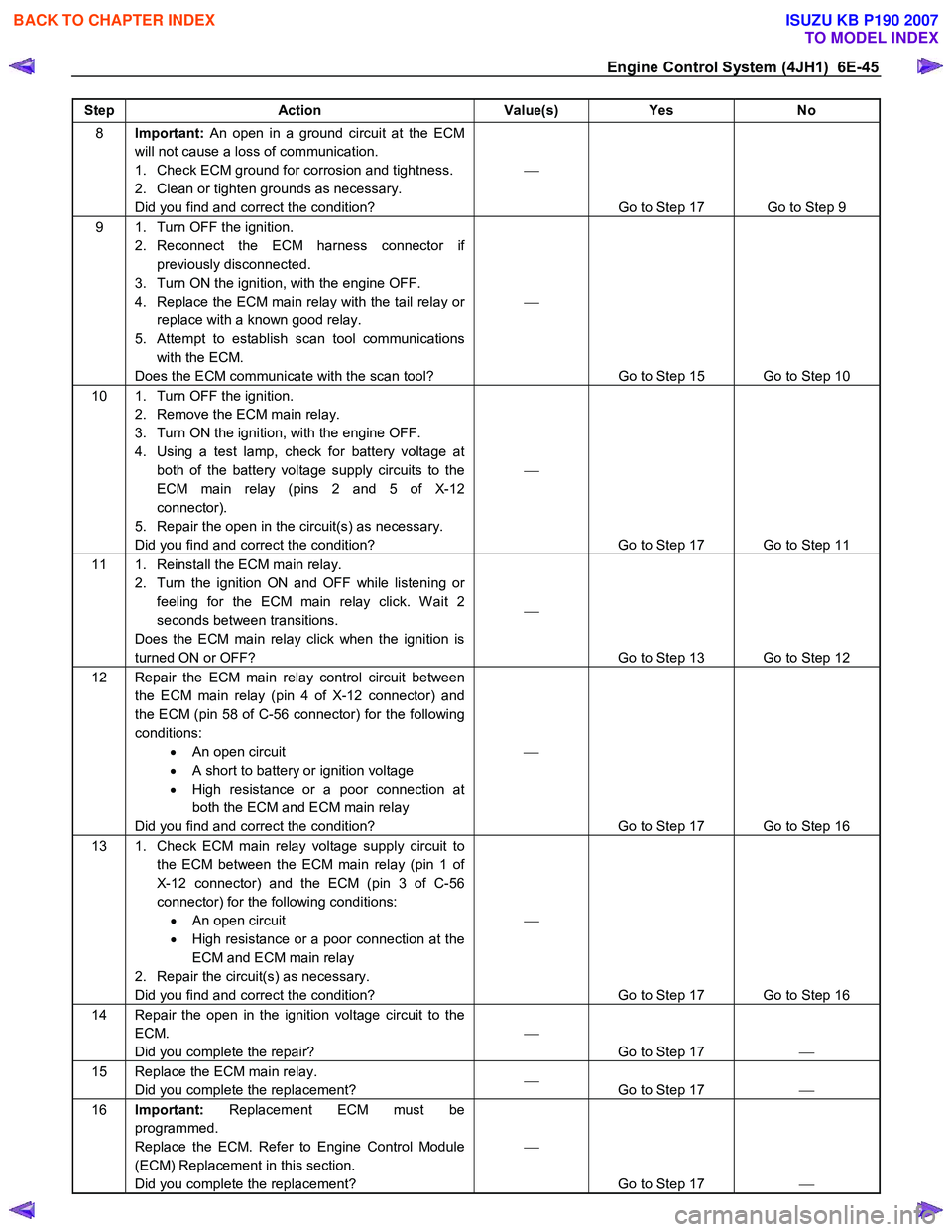
Engine Control System (4JH1) 6E-45
Step Action Value(s) Yes No
8 Important: An open in a ground circuit at the ECM
will not cause a loss of communication.
1. Check ECM ground for corrosion and tightness.
2. Clean or tighten grounds as necessary.
Did you find and correct the condition?
Go to Step 17 Go to Step 9
9 1. Turn OFF the ignition. 2. Reconnect the ECM harness connector if previously disconnected.
3. Turn ON the ignition, with the engine OFF.
4. Replace the ECM main relay with the tail relay or replace with a known good relay.
5. Attempt to establish scan tool communications with the ECM.
Does the ECM communicate with the scan tool?
Go to Step 15 Go to Step 10
10 1. Turn OFF the ignition. 2. Remove the ECM main relay.
3. Turn ON the ignition, with the engine OFF.
4. Using a test lamp, check for battery voltage at both of the battery voltage supply circuits to the
ECM main relay (pins 2 and 5 of X-12
connector).
5. Repair the open in the circuit(s) as necessary.
Did you find and correct the condition?
Go to Step 17 Go to Step 11
11 1. Reinstall the ECM main relay. 2. Turn the ignition ON and OFF while listening or feeling for the ECM main relay click. W ait 2
seconds between transitions.
Does the ECM main relay click when the ignition is
turned ON or OFF?
Go to Step 13 Go to Step 12
12 Repair the ECM main relay control circuit between the ECM main relay (pin 4 of X-12 connector) and
the ECM (pin 58 of C-56 connector) for the following
conditions: • An open circuit
• A short to battery or ignition voltage
• High resistance or a poor connection at
both the ECM and ECM main relay
Did you find and correct the condition?
Go to Step 17 Go to Step 16
13 1. Check ECM main relay voltage supply circuit to the ECM between the ECM main relay (pin 1 of
X-12 connector) and the ECM (pin 3 of C-56
connector) for the following conditions: • An open circuit
• High resistance or a poor connection at the
ECM and ECM main relay
2. Repair the circuit(s) as necessary.
Did you find and correct the condition?
Go to Step 17 Go to Step 16
14 Repair the open in the ignition voltage circuit to the ECM.
Did you complete the repair?
Go to Step 17
15 Replace the ECM main relay.
Did you complete the replacement?
Go to Step 17
16 Important: Replacement ECM must be
programmed.
Replace the ECM. Refer to Engine Control Module
(ECM) Replacement in this section.
Did you complete the replacement?
Go to Step 17
BACK TO CHAPTER INDEX
TO MODEL INDEX
ISUZU KB P190 2007
Page 1081 of 6020
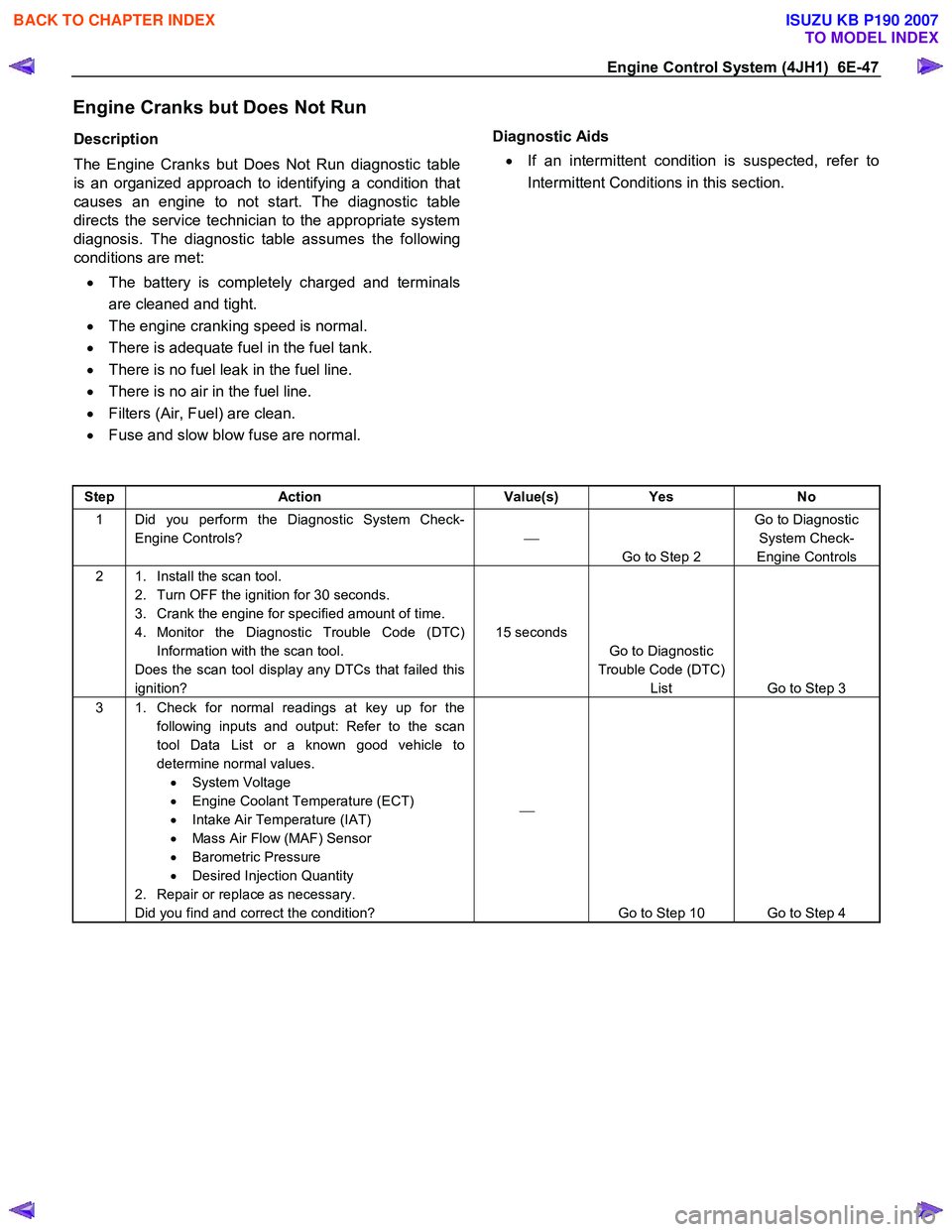
Engine Control System (4JH1) 6E-47
Engine Cranks but Does Not Run
Description
The Engine Cranks but Does Not Run diagnostic table
is an organized approach to identifying a condition that
causes an engine to not start. The diagnostic table
directs the service technician to the appropriate system
diagnosis. The diagnostic table assumes the following
conditions are met:
• The battery is completely charged and terminals
are cleaned and tight.
• The engine cranking speed is normal.
• There is adequate fuel in the fuel tank.
• There is no fuel leak in the fuel line.
• There is no air in the fuel line.
• Filters (Air, Fuel) are clean.
• Fuse and slow blow fuse are normal.
Diagnostic Aids
• If an intermittent condition is suspected, refer to
Intermittent Conditions in this section.
Step Action Value(s) Yes No
1 Did you perform the Diagnostic System Check-
Engine Controls?
Go to Step 2 Go to Diagnostic
System Check-
Engine Controls
2 1. Install the scan tool. 2. Turn OFF the ignition for 30 seconds.
3. Crank the engine for specified amount of time.
4. Monitor the Diagnostic Trouble Code (DTC) Information with the scan tool.
Does the scan tool display any DTCs that failed this
ignition? 15 seconds
Go to Diagnostic
Trouble Code (DTC) List Go to Step 3
3 1. Check for normal readings at key up for the
following inputs and output: Refer to the scan
tool Data List or a known good vehicle to
determine normal values. • System Voltage
• Engine Coolant Temperature (ECT)
• Intake Air Temperature (IAT)
• Mass Air Flow (MAF) Sensor
• Barometric Pressure
• Desired Injection Quantity
2. Repair or replace as necessary.
Did you find and correct the condition?
Go to Step 10 Go to Step 4
BACK TO CHAPTER INDEX
TO MODEL INDEX
ISUZU KB P190 2007
Page 1082 of 6020
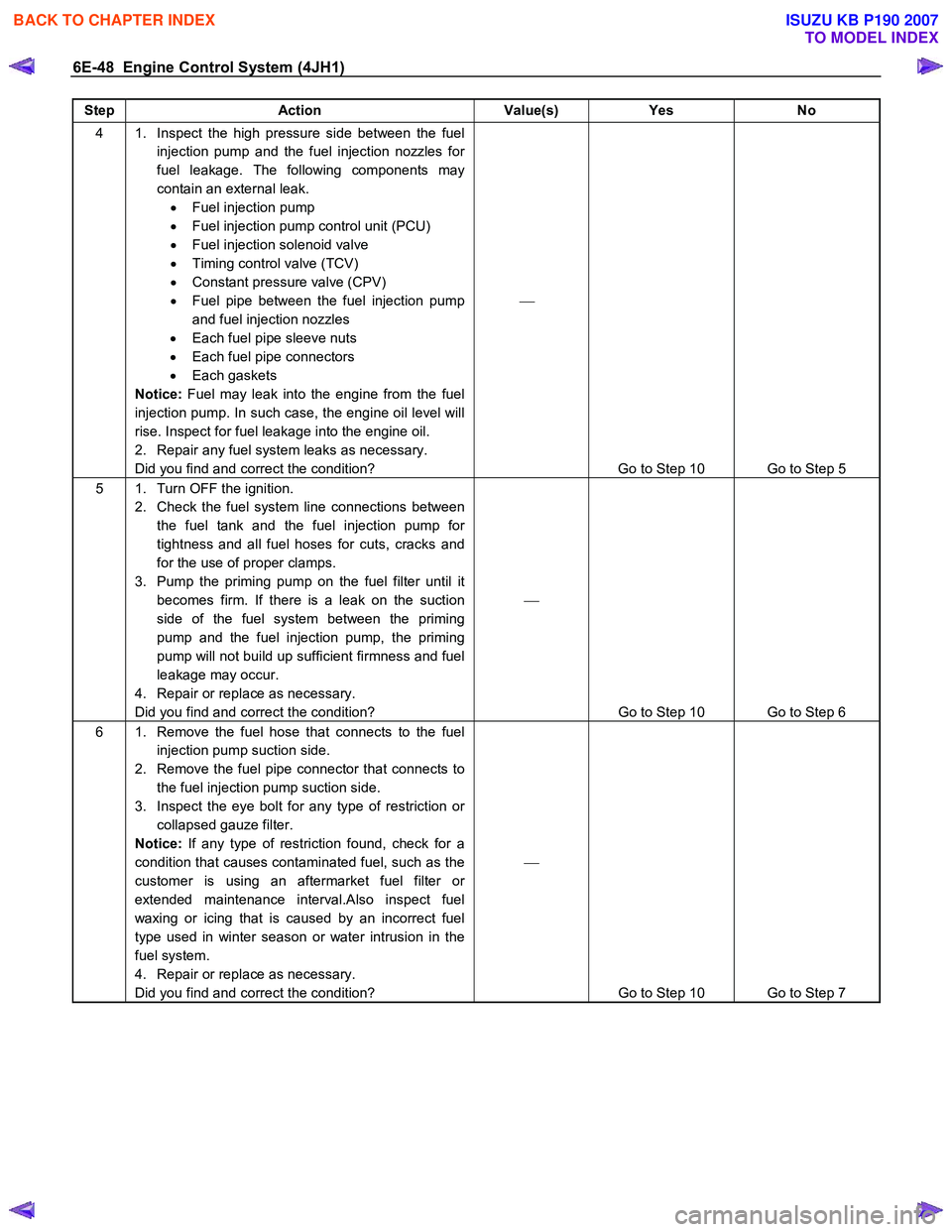
6E-48 Engine Control System (4JH1)
Step Action Value(s) Yes No
4 1. Inspect the high pressure side between the fuel
injection pump and the fuel injection nozzles for
fuel leakage. The following components may
contain an external leak. • Fuel injection pump
• Fuel injection pump control unit (PCU)
• Fuel injection solenoid valve
• Timing control valve (TCV)
• Constant pressure valve (CPV)
• Fuel pipe between the fuel injection pump
and fuel injection nozzles
• Each fuel pipe sleeve nuts
• Each fuel pipe connectors
• Each gaskets
Notice: Fuel may leak into the engine from the fuel
injection pump. In such case, the engine oil level will
rise. Inspect for fuel leakage into the engine oil.
2. Repair any fuel system leaks as necessary.
Did you find and correct the condition?
Go to Step 10 Go to Step 5
5 1. Turn OFF the ignition. 2. Check the fuel system line connections between the fuel tank and the fuel injection pump for
tightness and all fuel hoses for cuts, cracks and
for the use of proper clamps.
3. Pump the priming pump on the fuel filter until it becomes firm. If there is a leak on the suction
side of the fuel system between the priming
pump and the fuel injection pump, the priming
pump will not build up sufficient firmness and fuel
leakage may occur.
4. Repair or replace as necessary.
Did you find and correct the condition?
Go to Step 10 Go to Step 6
6 1. Remove the fuel hose that connects to the fuel injection pump suction side.
2. Remove the fuel pipe connector that connects to the fuel injection pump suction side.
3. Inspect the eye bolt for any type of restriction or collapsed gauze filter.
Notice: If any type of restriction found, check for a
condition that causes contaminated fuel, such as the
customer is using an aftermarket fuel filter or
extended maintenance interval.Also inspect fuel
waxing or icing that is caused by an incorrect fuel
type used in winter season or water intrusion in the
fuel system.
4. Repair or replace as necessary.
Did you find and correct the condition?
Go to Step 10 Go to Step 7
BACK TO CHAPTER INDEX
TO MODEL INDEX
ISUZU KB P190 2007
Page 1083 of 6020
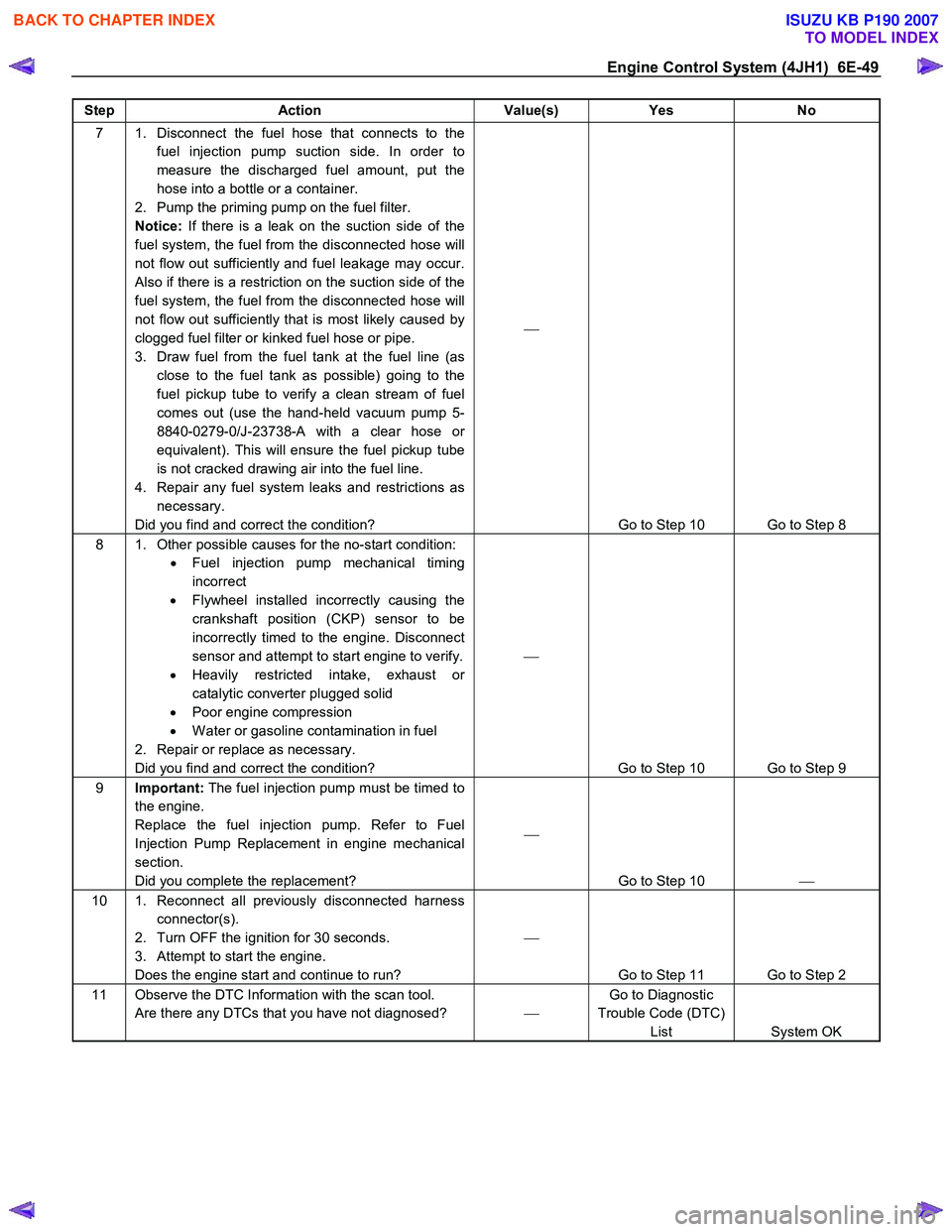
Engine Control System (4JH1) 6E-49
Step Action Value(s) Yes No
7 1. Disconnect the fuel hose that connects to the
fuel injection pump suction side. In order to
measure the discharged fuel amount, put the
hose into a bottle or a container.
2. Pump the priming pump on the fuel filter.
Notice: If there is a leak on the suction side of the
fuel system, the fuel from the disconnected hose will
not flow out sufficiently and fuel leakage may occur.
Also if there is a restriction on the suction side of the
fuel system, the fuel from the disconnected hose will
not flow out sufficiently that is most likely caused by
clogged fuel filter or kinked fuel hose or pipe.
3. Draw fuel from the fuel tank at the fuel line (as close to the fuel tank as possible) going to the
fuel pickup tube to verify a clean stream of fuel
comes out (use the hand-held vacuum pump 5-
8840-0279-0/J-23738-A with a clear hose or
equivalent). This will ensure the fuel pickup tube
is not cracked drawing air into the fuel line.
4. Repair any fuel system leaks and restrictions as necessary.
Did you find and correct the condition?
Go to Step 10 Go to Step 8
8 1. Other possible causes for the no-start condition: • Fuel injection pump mechanical timing
incorrect
• Flywheel installed incorrectly causing the
crankshaft position (CKP) sensor to be
incorrectly timed to the engine. Disconnect
sensor and attempt to start engine to verify.
• Heavily restricted intake, exhaust or
catalytic converter plugged solid
• Poor engine compression
• W ater or gasoline contamination in fuel
2. Repair or replace as necessary.
Did you find and correct the condition?
Go to Step 10 Go to Step 9
9 Important: The fuel injection pump must be timed to
the engine.
Replace the fuel injection pump. Refer to Fuel
Injection Pump Replacement in engine mechanical
section.
Did you complete the replacement?
Go to Step 10
10 1. Reconnect all previously disconnected harness
connector(s).
2. Turn OFF the ignition for 30 seconds.
3. Attempt to start the engine.
Does the engine start and continue to run?
Go to Step 11 Go to Step 2
11 Observe the DTC Information with the scan tool. Are there any DTCs that you have not diagnosed? Go to Diagnostic
Trouble Code (DTC) List System OK
BACK TO CHAPTER INDEX
TO MODEL INDEX
ISUZU KB P190 2007
Page 1084 of 6020

6E-50 Engine Control System (4JH1)
Diagnostic Trouble Code (DTC) List
DTC
(Symptom Code) Flash
Code MIL
Status DTC Name on
scan tool Condition for
Running the DTC Condition for
Setting the DTC Possible Cause
P0100
(7) 65 ON Mass Air Flow
(MAF) Sensor
Circuit 5V
Reference High
Voltage •
The ignition switch
is ON.
•
The ECM detects
that the MAF sensor
5 volts reference
circuit voltage is
more than 5.2 volts
for 0.5 seconds. •
Sensor 5V reference circuit is
short to battery or ignition
voltage.
• Sensor 5V reference circuit is
short to the sensor ignition
voltage circuit.
• Faulty MAF sensor.
• Faulty ECM.
P0100 (9) 65 ON Mass Air Flow
(MAF) Sensor
Voltage 5V
Reference Circuit
Low Voltage •
The ignition switch
is ON.
•
The ECM detects
that the MAF sensor
5 volts reference
circuit voltage is
less than 4.6 volts
for 0.5 seconds. •
Sensor 5V reference circuit is
short to ground.
• Sensor 5V reference circuit is
short to the low reference circuit.
• Faulty MAF sensor.
• Faulty ECM.
P0100 (B) 65 ON Mass Air Flow
(MAF) Sensor
Circuit Low
Voltage •
The ignition switch
is ON.
• The engine is
running.
•
The ECM calculated
MAF is lower than -
18.6 kg/h for 5
seconds.
•
ECM (10A) fuse (EB1) open.
• Sensor ignition voltage feed
circuit is open circuit or high
resistance.
• Sensor 5V reference circuit is
open circuit, high resistance,
short to ground or short to the
low reference circuit.
• Sensor signal circuit is open
circuit, high resistance, short to
ground or short to the low
reference circuit.
• Poor harness connector
connection.
• Faulty MAF sensor installation.
• Faulty MAF sensor.
• Faulty ECM.
P0100 (C) 65 ON Mass Air Flow
(MAF) Sensor
Circuit High
Voltage •
The ignition switch
is ON.
• The engine is
running.
•
The ECM calculated
MAF is higher than
984 kg/h for 10
seconds.
•
Sensor signal circuit is short to
any 5V reference circuit, short to
battery or ignition voltage circuit.
• Sensor low reference circuit is
open circuit or high resistance.
• Poor harness connector
connection.
• Faulty MAF sensor.
• Faulty ECM.
P0105 (1) 34 ON Vacuum Pressure
Sensor Circuit
High Voltage •
The ignition switch
is ON. •
The ECM detects
that the vacuum
pressure sensor
signal voltage is
more than 4.4 volts
for 3 seconds. •
Sensor 5V reference circuit is
short to battery or ignition
voltage.
• Sensor signal circuit is short to
any 5V reference circuit, short to
battery or ignition voltage.
• Sensor low reference circuit is
open circuit or high resistance.
• Poor harness connector
connection.
• Faulty vacuum pressure sensor.
• Faulty ECM.
BACK TO CHAPTER INDEX
TO MODEL INDEX
ISUZU KB P190 2007
Page 1085 of 6020
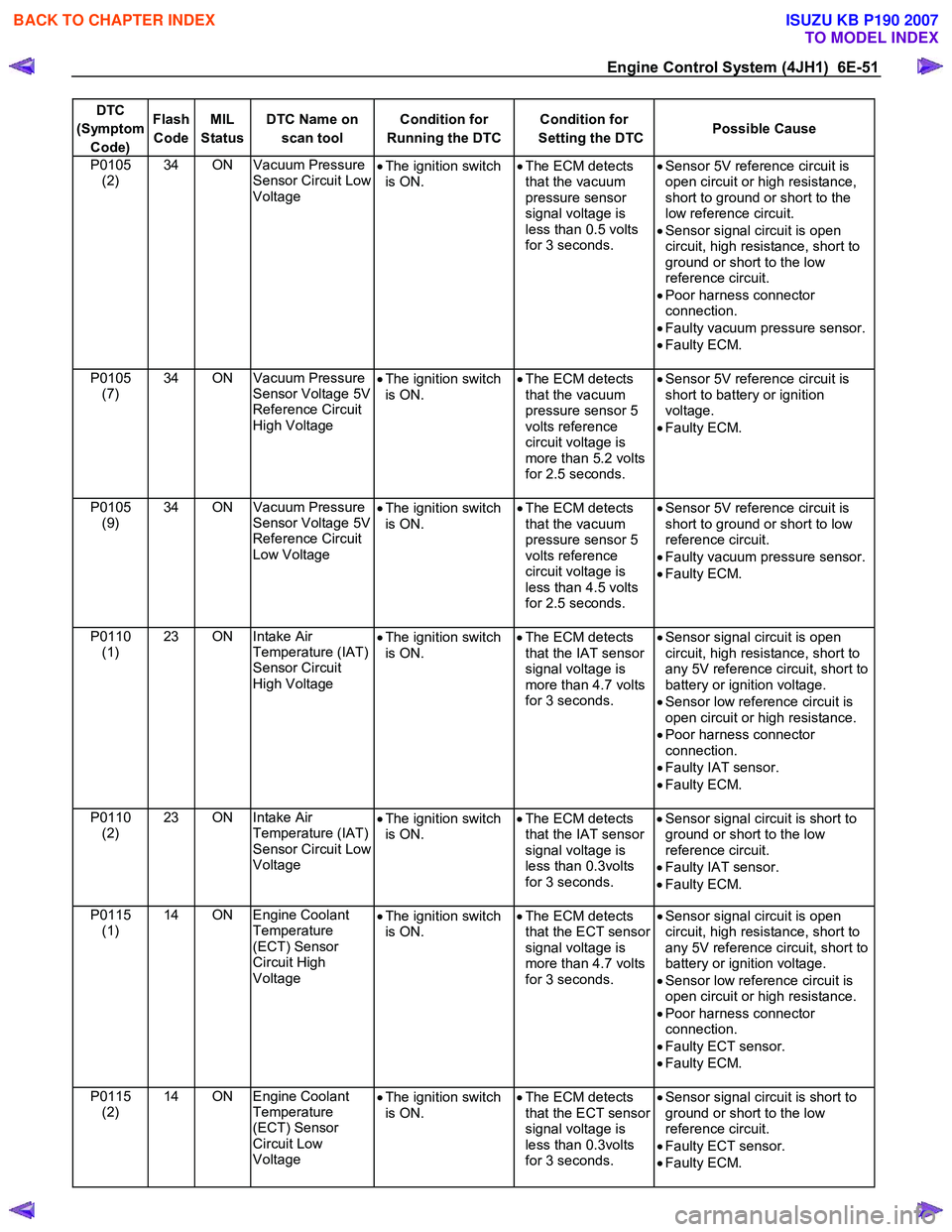
Engine Control System (4JH1) 6E-51
DTC
(Symptom Code) Flash
Code MIL
Status DTC Name on
scan tool Condition for
Running the DTC Condition for
Setting the DTC Possible Cause
P0105
(2) 34 ON Vacuum Pressure
Sensor Circuit Low
Voltage •
The ignition switch
is ON. •
The ECM detects
that the vacuum
pressure sensor
signal voltage is
less than 0.5 volts
for 3 seconds. •
Sensor 5V reference circuit is
open circuit or high resistance,
short to ground or short to the
low reference circuit.
• Sensor signal circuit is open
circuit, high resistance, short to
ground or short to the low
reference circuit.
• Poor harness connector
connection.
• Faulty vacuum pressure sensor.
• Faulty ECM.
P0105 (7) 34 ON Vacuum Pressure
Sensor Voltage 5V
Reference Circuit
High Voltage
•
The ignition switch
is ON. •
The ECM detects
that the vacuum
pressure sensor 5
volts reference
circuit voltage is
more than 5.2 volts
for 2.5 seconds.
•
Sensor 5V reference circuit is
short to battery or ignition
voltage.
• Faulty ECM.
P0105 (9) 34 ON Vacuum Pressure
Sensor Voltage 5V
Reference Circuit
Low Voltage
•
The ignition switch
is ON. •
The ECM detects
that the vacuum
pressure sensor 5
volts reference
circuit voltage is
less than 4.5 volts
for 2.5 seconds.
•
Sensor 5V reference circuit is
short to ground or short to low
reference circuit.
• Faulty vacuum pressure sensor.
• Faulty ECM.
P0110 (1) 23 ON Intake Air
Temperature (IAT)
Sensor Circuit
High Voltage •
The ignition switch
is ON.
•
The ECM detects
that the IAT sensor
signal voltage is
more than 4.7 volts
for 3 seconds. •
Sensor signal circuit is open
circuit, high resistance, short to
any 5V reference circuit, short to
battery or ignition voltage.
• Sensor low reference circuit is
open circuit or high resistance.
• Poor harness connector
connection.
• Faulty IAT sensor.
• Faulty ECM.
P0110 (2) 23 ON Intake Air
Temperature (IAT)
Sensor Circuit Low
Voltage
•
The ignition switch
is ON.
•
The ECM detects
that the IAT sensor
signal voltage is
less than 0.3volts
for 3 seconds.
•
Sensor signal circuit is short to
ground or short to the low
reference circuit.
• Faulty IAT sensor.
• Faulty ECM.
P0115
(1) 14 ON Engine Coolant
Temperature
(ECT) Sensor
Circuit High
Voltage •
The ignition switch
is ON.
•
The ECM detects
that the ECT sensor
signal voltage is
more than 4.7 volts
for 3 seconds. •
Sensor signal circuit is open
circuit, high resistance, short to
any 5V reference circuit, short to
battery or ignition voltage.
• Sensor low reference circuit is
open circuit or high resistance.
• Poor harness connector
connection.
• Faulty ECT sensor.
• Faulty ECM.
P0115 (2) 14 ON Engine Coolant
Temperature
(ECT) Sensor
Circuit Low
Voltage
•
The ignition switch
is ON.
•
The ECM detects
that the ECT sensor
signal voltage is
less than 0.3volts
for 3 seconds. •
Sensor signal circuit is short to
ground or short to the low
reference circuit.
• Faulty ECT sensor.
• Faulty ECM.
BACK TO CHAPTER INDEX
TO MODEL INDEX
ISUZU KB P190 2007
Page 1086 of 6020
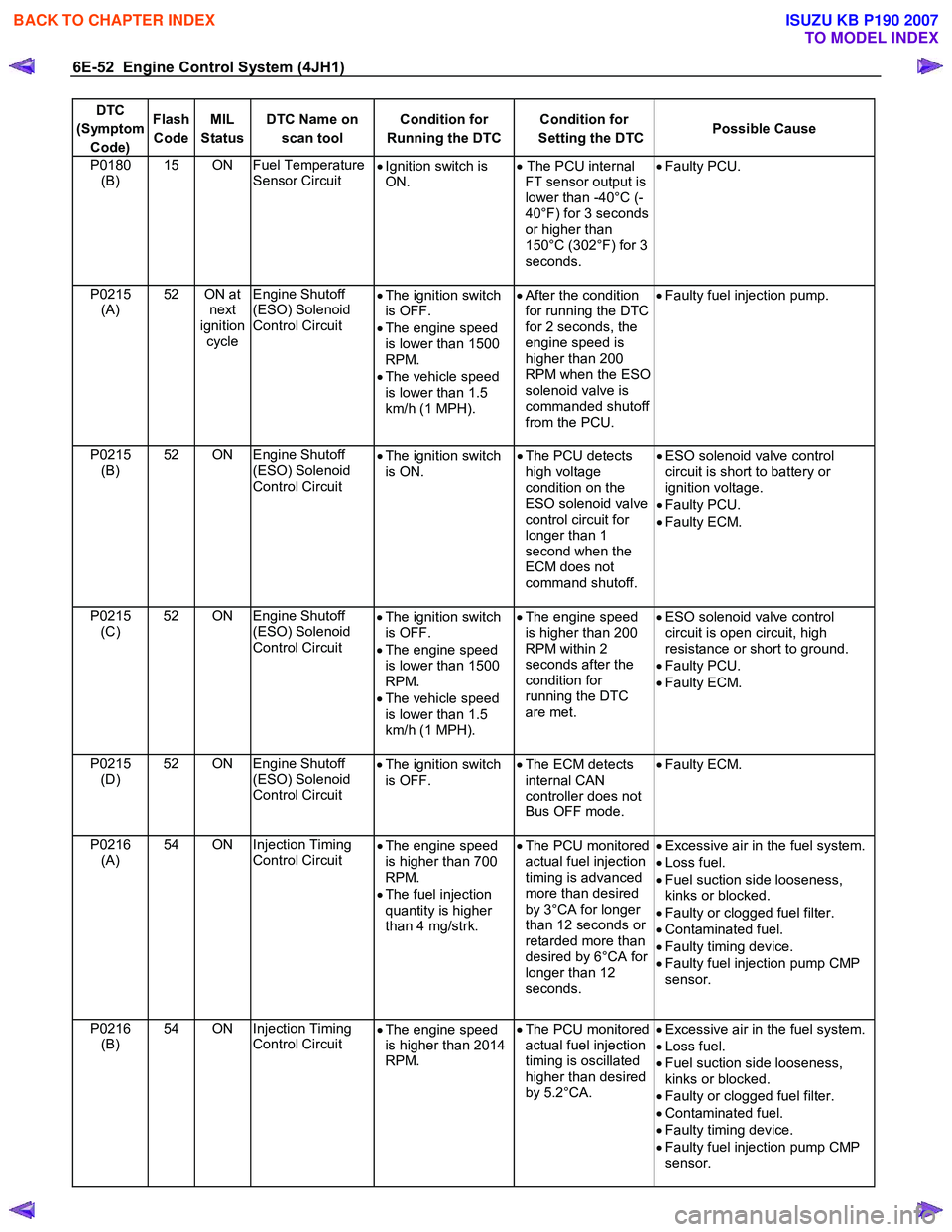
6E-52 Engine Control System (4JH1)
DTC
(Symptom Code) Flash
Code MIL
Status DTC Name on
scan tool Condition for
Running the DTC Condition for
Setting the DTC Possible Cause
P0180
(B) 15 ON Fuel Temperature
Sensor Circuit •
Ignition switch is
ON.
•
The PCU internal
FT sensor output is
lower than -40°C (-
40°F) for 3 seconds
or higher than
150°C (302°F) for 3
seconds.
•
Faulty PCU.
P0215 (A) 52 ON at
next
ignition cycle Engine Shutoff
(ESO) Solenoid
Control Circuit •
The ignition switch
is OFF.
• The engine speed
is lower than 1500
RPM.
• The vehicle speed
is lower than 1.5
km/h (1 MPH).
•
After the condition
for running the DTC
for 2 seconds, the
engine speed is
higher than 200
RPM when the ESO
solenoid valve is
commanded shutoff
from the PCU.
•
Faulty fuel injection pump.
P0215 (B) 52 ON Engine Shutoff
(ESO) Solenoid
Control Circuit •
The ignition switch
is ON. •
The PCU detects
high voltage
condition on the
ESO solenoid valve
control circuit for
longer than 1
second when the
ECM does not
command shutoff.
•
ESO solenoid valve control
circuit is short to battery or
ignition voltage.
• Faulty PCU.
• Faulty ECM.
P0215 (C) 52 ON Engine Shutoff
(ESO) Solenoid
Control Circuit •
The ignition switch
is OFF.
• The engine speed
is lower than 1500
RPM.
• The vehicle speed
is lower than 1.5
km/h (1 MPH).
•
The engine speed
is higher than 200
RPM within 2
seconds after the
condition for
running the DTC
are met.
•
ESO solenoid valve control
circuit is open circuit, high
resistance or short to ground.
• Faulty PCU.
• Faulty ECM.
P0215 (D) 52 ON Engine Shutoff
(ESO) Solenoid
Control Circuit
•
The ignition switch
is OFF. •
The ECM detects
internal CAN
controller does not
Bus OFF mode.
•
Faulty ECM.
P0216 (A) 54 ON Injection Timing
Control Circuit •
The engine speed
is higher than 700
RPM.
• The fuel injection
quantity is higher
than 4 mg/strk.
•
The PCU monitored
actual fuel injection
timing is advanced
more than desired
by 3°CA for longer
than 12 seconds or
retarded more than
desired by 6°CA for
longer than 12
seconds.
•
Excessive air in the fuel system.
• Loss fuel.
• Fuel suction side looseness,
kinks or blocked.
• Faulty or clogged fuel filter.
• Contaminated fuel.
• Faulty timing device.
• Faulty fuel injection pump CMP
sensor.
P0216 (B) 54 ON Injection Timing
Control Circuit •
The engine speed
is higher than 2014
RPM.
•
The PCU monitored
actual fuel injection
timing is oscillated
higher than desired
by 5.2°CA.
•
Excessive air in the fuel system.
• Loss fuel.
• Fuel suction side looseness,
kinks or blocked.
• Faulty or clogged fuel filter.
• Contaminated fuel.
• Faulty timing device.
• Faulty fuel injection pump CMP
sensor.
BACK TO CHAPTER INDEX
TO MODEL INDEX
ISUZU KB P190 2007
Page 1090 of 6020
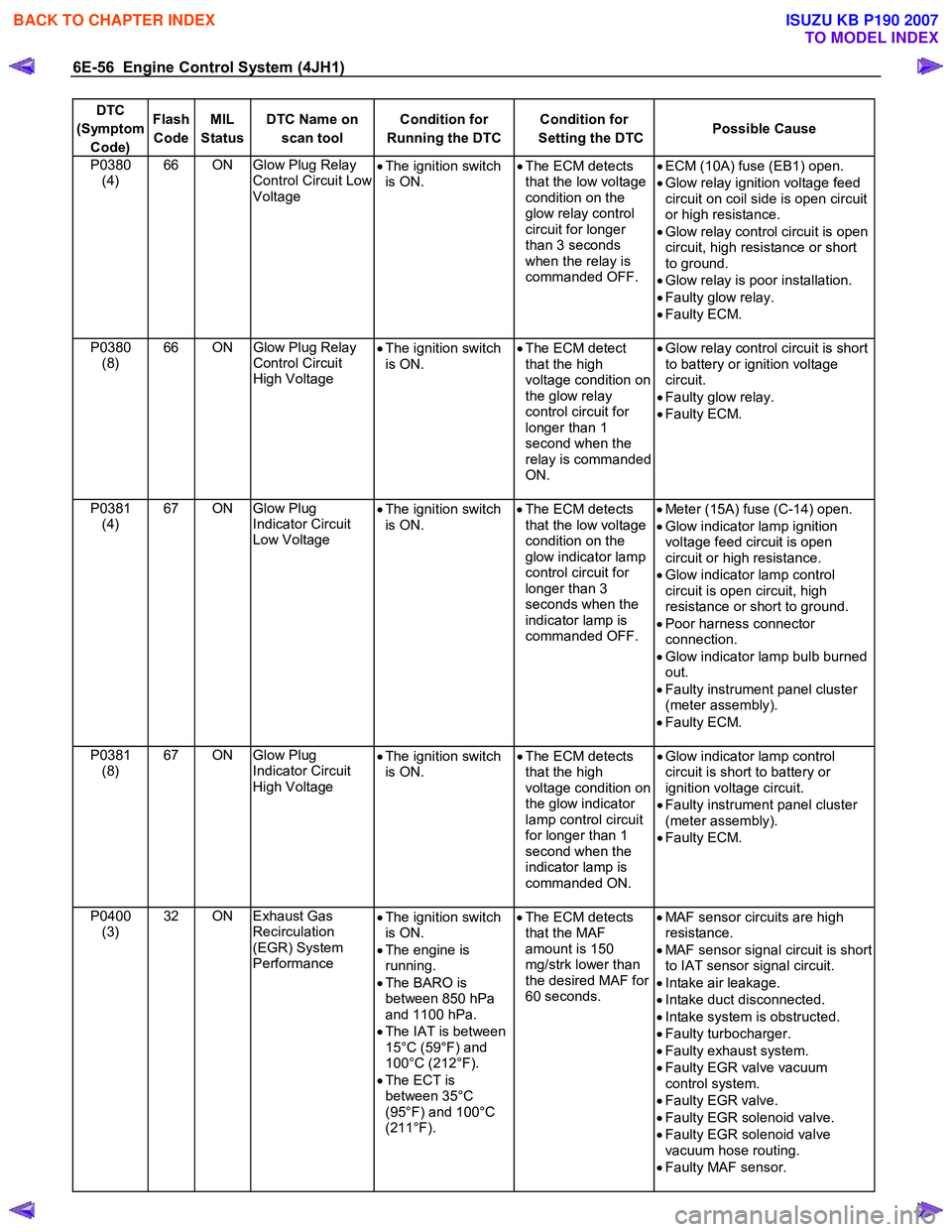
6E-56 Engine Control System (4JH1)
DTC
(Symptom Code) Flash
Code MIL
Status DTC Name on
scan tool Condition for
Running the DTC Condition for
Setting the DTC Possible Cause
P0380
(4) 66 ON Glow Plug Relay
Control Circuit Low
Voltage •
The ignition switch
is ON. •
The ECM detects
that the low voltage
condition on the
glow relay control
circuit for longer
than 3 seconds
when the relay is
commanded OFF.
•
ECM (10A) fuse (EB1) open.
• Glow relay ignition voltage feed
circuit on coil side is open circuit
or high resistance.
• Glow relay control circuit is open
circuit, high resistance or short
to ground.
• Glow relay is poor installation.
• Faulty glow relay.
• Faulty ECM.
P0380 (8) 66 ON
Glow Plug Relay
Control Circuit
High Voltage •
The ignition switch
is ON. •
The ECM detect
that the high
voltage condition on
the glow relay
control circuit for
longer than 1
second when the
relay is commanded
ON.
•
Glow relay control circuit is short
to battery or ignition voltage
circuit.
• Faulty glow relay.
• Faulty ECM.
P0381 (4) 67 ON Glow Plug
Indicator Circuit
Low Voltage •
The ignition switch
is ON.
•
The ECM detects
that the low voltage
condition on the
glow indicator lamp
control circuit for
longer than 3
seconds when the
indicator lamp is
commanded OFF.
•
Meter (15A) fuse (C-14) open.
• Glow indicator lamp ignition
voltage feed circuit is open
circuit or high resistance.
• Glow indicator lamp control
circuit is open circuit, high
resistance or short to ground.
• Poor harness connector
connection.
• Glow indicator lamp bulb burned
out.
• Faulty instrument panel cluster
(meter assembly).
• Faulty ECM.
P0381 (8) 67 ON Glow Plug
Indicator Circuit
High Voltage •
The ignition switch
is ON. •
The ECM detects
that the high
voltage condition on
the glow indicator
lamp control circuit
for longer than 1
second when the
indicator lamp is
commanded ON.
•
Glow indicator lamp control
circuit is short to battery or
ignition voltage circuit.
• Faulty instrument panel cluster
(meter assembly).
• Faulty ECM.
P0400 (3) 32 ON Exhaust Gas
Recirculation
(EGR) System
Performance •
The ignition switch
is ON.
• The engine is
running.
• The BARO is
between 850 hPa
and 1100 hPa.
• The IAT is between
15°C (59°F) and
100°C (212°F).
• The ECT is
between 35°C
(95°F) and 100°C
(211°F).
•
The ECM detects
that the MAF
amount is 150
mg/strk lower than
the desired MAF for
60 seconds.
•
MAF sensor circuits are high
resistance.
• MAF sensor signal circuit is short
to IAT sensor signal circuit.
• Intake air leakage.
• Intake duct disconnected.
• Intake system is obstructed.
• Faulty turbocharger.
• Faulty exhaust system.
• Faulty EGR valve vacuum
control system.
• Faulty EGR valve.
• Faulty EGR solenoid valve.
• Faulty EGR solenoid valve
vacuum hose routing.
• Faulty MAF sensor.
BACK TO CHAPTER INDEX
TO MODEL INDEX
ISUZU KB P190 2007